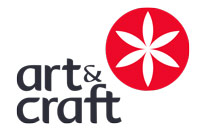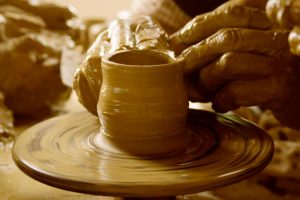-The clay is extracted and cleansed of impurities, then is battered with water and left to leaven for a few weeks. Thereafter, the clay is cut into big chunks, beaten with cornflower and sprayed with water.
-These chunks are laid on a wooden board in the craftsman’s studio, where the most painstaking and important step ensues in order to obtain quality clay. The clay is kneaded with the feet, then with the hands until it gets an oily coating, and then it is cut into thin slices, which are then mixed and beaten with cornflower to obtain a homogenized paste. This paste is then divided in equal balls, which are then shaped on the potter’s wheel (wooden tool, made of two round disks, a smaller one up on top and a bigger one on the bottom, connected through a vertical axe, about 50-60 cm tall).
-The clay ball is laid down on the upper disk of the potter’s wheel, while the potter, with a rather fast circular movement of the foot, spins the lower disk. The shaping of a simple pottery item doesn’t last more than a minute, during which it goes through various geometrical shapes: sphere, truncated cone, cylinder etc.
-After it’s shaped, the pottery item is left to dry for several days, and then it is covered with a white or red paste made of loam cut with water, to coat over any defect that could surge as a result of the shaping phase.
-Before being burned in the special oven, the clay dish is decorated, either through the deepening of the surface, or bas-relief or painting, with diverse motifs and symbols, in a diverse of chromatic scale (red ceramic is of Roman origin, and green, yellow and white have byzantine influences). The most frequently used decoration technique is through a cow horn, with the tip made of goose feather, and for the finest adornment the craftsmen use a stick made of boar hair.
-The last phase entails burning the clay dish in special ceramic baking ovens for approximately 12 hours, while the fire is permanently kept, alternating the temperature according to the phase of the process.
In our country, the most important pottery centers are found in Baia Mare, Corund, Cucuteni and Horezu, with Horezu ceramic a part of the UNESCO Cultural Patrimony since 2012. We will talk about each type of ceramic individually in the next articles.





